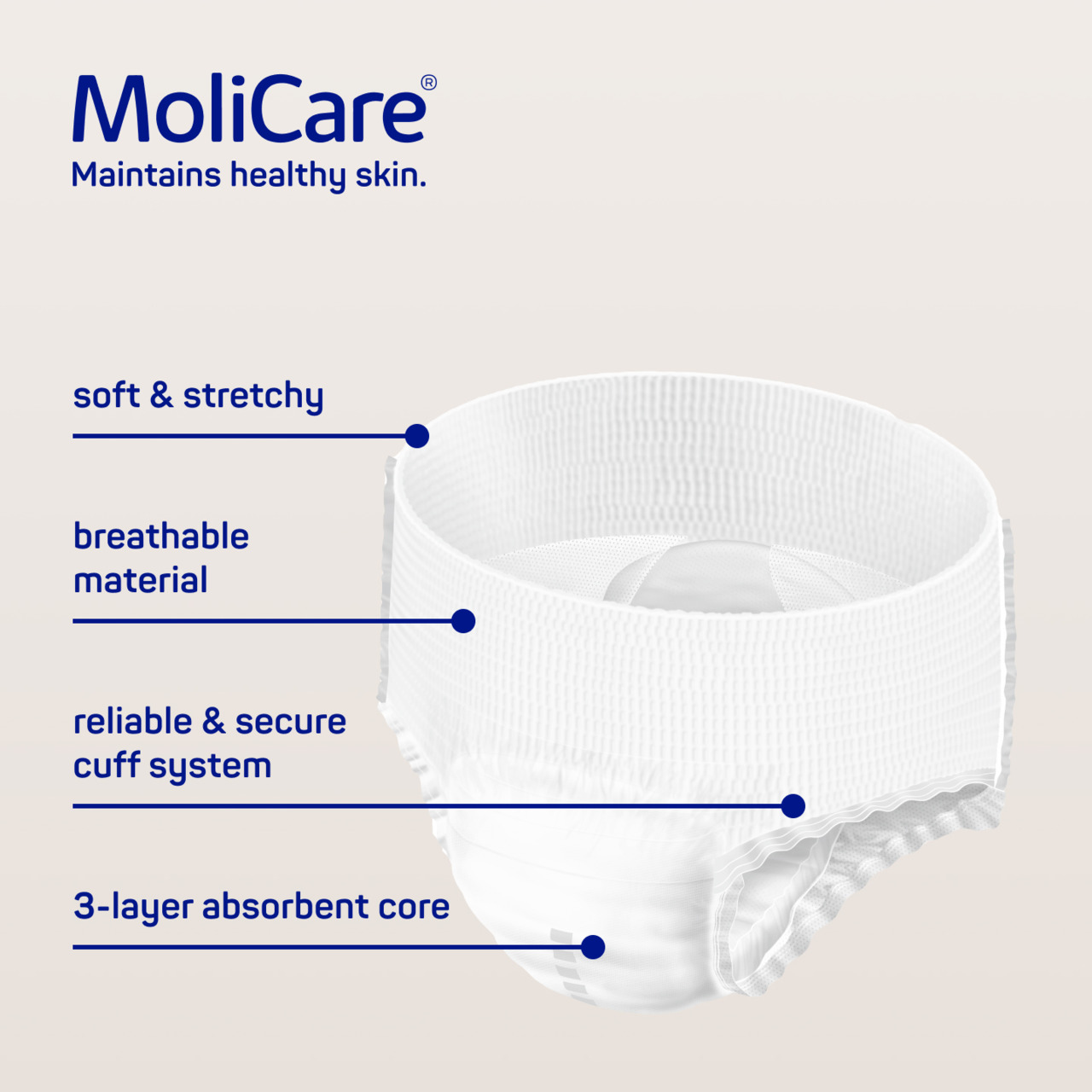What causes urinary incontinence?
World Continence Week #WCW23
Whether you’ve been living with bladder weakness (incontinence) for years or if it’s relatively new to you, you’re not alone and many people ask themselves, ‘what causes urinary incontinence?’. In this article, we’ve partnered with MoliCare®, the incontinence brand from HARTMANN, to take a closer look at the world of the urinary tract and uncover the root causes of bladder weakness.
How urinary incontinence can start
Normally, we empty our bladder between four to seven times a day when we feel the urge to go to the toilet. Behind this is a complicated interaction between the bladder and the nervous system. If there are any problems with these communication signals, there is a risk of developing urinary incontinence. We learn how to control our bladder from a young age, but for people living with certain neurological diseases such as multiple sclerosis, and the natural ageing process may cause involuntary loss of urine. In other people, bladder leakages might happen when they sneeze, jump or lift heavy objects or even without any apparent reason.
Common causes of urinary incontinence
In men, prostate surgery is one of the most common causes of urinary incontinence because the surgery usually includes removal of part of the sphincter muscle. Even before the removal of their prostate, men also often experience overflow incontinence (or chronic urinary retention) which is caused by part of the urethra being constricted or blocked by the prostate.
In women pregnancy as well as the hormonal changes prior to menopause (perimenopause) weaken the pelvic floor muscles which can lead to bladder weakness. This type of involuntary loss of urine is often what we would call stress incontinence.
Because there are different causes of incontinence, MoliCare® say the first step in treating bladder weakness is to identify with your doctor what the underlying problem is. Watch a short video on causes and types of incontinence easily explained.
Only with the right diagnosis will your therapy be tailored to your individual needs. Absorbent pads and underwear can help you manage any bladder weakness and incontinence throughout your journey, buy MoliCare® from Countrywide, a leading specialist in care products in the UK.
Let’s look now at the structure of the urinary tract and how bladder weakness can develop.
Anatomy and the function of the urinary tract
In women the bladder lies immediately in front of (slightly below) the uterus while in men it is next to the rectum. It is protected by the pelvis and is connected to the kidneys by the two tubes called ‘ureters’ that fill the bladder with urine. When the bladder is about half full, special receptors signal the brain. We then feel the urge to go to the toilet which becomes stronger and stronger. Fortunately, the bladder is highly elastic, which means that when it’s healthy, it can keep filling with urine. The capacity of the bladder varies enormously from person to person so, how much urine one person can hold will be different to the next.
We can consciously empty a full bladder thanks to the powerful sphincter muscle that can be deliberately relax to release urine. The pelvic floor muscles support the sphincter muscles and hold the urethra and neck of the bladder in position. A healthy urinary tract prevents involuntary loss of urine even if the bladder is full or is subjected to stress such as sneezing, coughing or physical exertion. When this process isn’t working properly, we can experience bladder leakages.
The pelvic floor and its importance for incontinence
MoliCare® explains that the pelvic floor can be thought of as an upside-down umbrella that is stretched between the pelvic bones and supports the bladder and the other organs of the lower abdomen. The pelvic floor muscles are made up of several muscle bundles that form the outer sphincter muscle that can be deliberately relaxed to release urine. Together with the inner sphincter muscle on the neck of the bladder, these muscles ensure that the bladder is closed when tensed.
The lower urinary tract with the bladder, urethra and sphincter system therefore has two functions that it must fulfil:
- the storage of urine and
- the controlled release of urine (miction).
Along with an intact bladder and sphincter muscles, a functioning nerve supply is also required.
Particularly with increasing age and, for example, after pregnancy, the muscles in the pelvic floor become weakened in many people. They can no longer perform their function, which can lead to involuntary loss of urine. However, the good news is that weak pelvic floor muscles can be trained, just like many other muscles in our bodies. Watch a short video on how to do a pelvic floor exercise.
Some neurological disorders such as stroke also disrupt the communication along the nerves between the urinary tract and the brain.
What happens when the bladder is emptied
Thanks to the elastic muscles of the bladder wall, we only notice that the bladder is filling when it reaches a certain level. If the urinary tract is healthy, the sphincter muscle system holds the opening of the urethra firmly closed during this filling phase.
If the bladder continues to be filled, then the bladder sends more and more messages that travel along the nerve pathways to the brain. As soon as these messages reach a certain intensity, we feel the urge to urinate. In healthy people this usually occurs with a volume of about 130 to 150 ml.2 If the urinary tract is healthy, at this point the urge to urinate can be held for a while until it becomes much stronger or it is possible to go to the toilet.
The emptying of the bladder can now be done deliberately with messages from the brain back to the bladder. The messages force urine out of the bladder and open the inner sphincter muscle while at the same time the pelvic floor muscles relax. As a result, the outer sphincter muscle also now opens and the urine is released. We can control urination even if the bladder only contains a small amount of urine and not when there is a strong urge to urinate.
As a guide, adults must empty their bladder about four to seven times a day, depending on the capacity of their bladder, their age and the volume of liquids taken in. One trip to the toilet overnight is also considered normal. Older people have to empty their bladders more often than younger people because of a smaller bladder capacity.3


Possible reasons for problems with urination
You can probably already guess how susceptible to problems the complex process of urine storage and urination is. In a nutshell, MoliCare® explains that there are four reasons that lead to problems with continence:
- The sphincter muscle system no longer has enough closing force.
- The bladder muscles tense up too much or not enough.
- An obstruction (such as an enlarged prostate) in the urethra prevents emptying of the bladder.
- The transmission of the messages (nerve impulses) between the bladder, spinal cord and brain is wholly or partly disrupted.
These functional problems in urination result from a wide range of reasons and lead to incontinence of varying severity.
The fault may lie with urinary tract infections, a weak pelvic floor or an enlarged prostate, for example. Changes in the brain, metabolic disorders, spinal cord injuries or the effects of medications can also cause problems.
Different types of incontinence
Based on the various functional disorders, urinary incontinence is classified into different types.
The most common types are
- stress incontinence
- urge incontinence (which is also commonly referred to as an overactive bladder)
- overflow incontinence (incontinence with chronic urinary retention)
In old age, a weak bladder is rarely due to only one cause and is therefore also known as mixed incontinence. Several factors play a role here. In addition to urinary incontinence, faecal incontinence can also occur in older people but this is considerably rarer.
Regardless of the type of incontinence, those affected can only be effectively helped if the cause is known. It is therefore important that a doctor accurately diagnoses the disorder and the type of urinary incontinence and tailors the treatment to the needs of the patient and the severity of the bladder weakness. For this reason a physical examination is essential.
With the appropriate therapy and the use of incontinence products, an active life is still possible even with bladder weakness. Take the first step today and make an appointment with your doctor.
Learn more about World Continence Week with MoliCare.
Visit the Countrywide online shop to view the Molicare range
Sources:
- https://www.prostata.de/prostata/beschwerden/harninkontinenz.
- https://prostata-hilfe-deutschland.de/gutartige-prostatavergroesserung-bph/
- https://www.krebsgesellschaft.de/onko-internetportal/basis-informationen-krebs/krebsarten/prostatakrebs/definition-und-haeufigkeit.html
- https://prostata-hilfe-deutschland.de/inkontinenz-prostatakrebs-behandlung/



